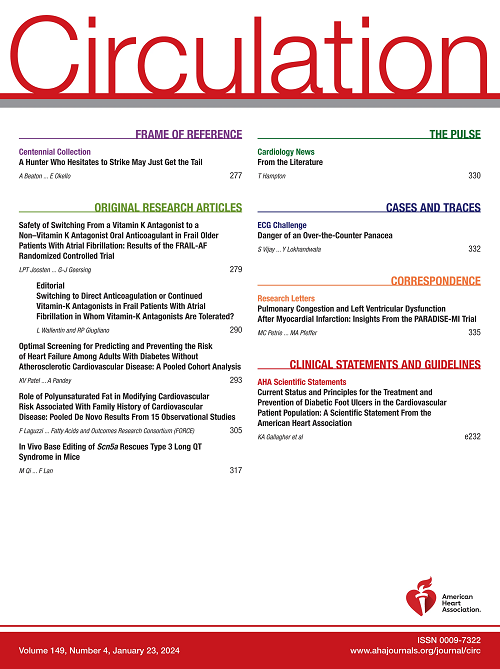非心脏胸部计算机断层扫描冠状动脉钙的机会性检测:心血管疾病预防的新兴工具:美国心脏协会的科学声明。
IF 38.6
1区 医学
Q1 CARDIAC & CARDIOVASCULAR SYSTEMS
引用次数: 0
摘要
冠状动脉钙(CAC)是亚临床动脉粥样硬化的标志,可增加动脉粥样硬化性心血管疾病的风险。通过非对比心脏计算机断层扫描测量,CAC改善了传统危险因素之外的风险分层,可以帮助决策分配预防性治疗。尽管国家指南建议考虑对美国1770万具有10年动脉粥样硬化性心血管疾病边缘至中等风险的人进行CAC测量,但采采量有限。一种有希望弥合这一差距的方法是利用非ecg门控胸部计算机断层扫描对CAC进行机会性检测,该扫描用于非心脏指征。每年大约进行1900万次非ecg门控胸部计算机断层扫描,从这些扫描中报告机会性检测CAC可以增强动脉粥样硬化性心血管疾病的风险分层,而无需额外的辐射暴露,成本或负担。传统的风险因素评分的风险评估没有得到充分利用,报告CAC的机会性检测有可能提醒医生注意风险,独立于指南推荐的风险计算器的使用。人工智能的进步使自动化CAC量化融入临床实践。一些人工智能算法被用于提高报告机会性检测CAC和适当分配预防治疗的可能性。需要系统的方法来确保适当的报告、解释和行动,同时避免不必要的下游测试。实施包括量身定制的预防保健和包括放射学、心脏病学和初级保健在内的多学科临床团队参与的精简护理途径至关重要。本文章由计算机程序翻译,如有差异,请以英文原文为准。
Opportunistic Detection of Coronary Artery Calcium on Noncardiac Chest Computed Tomography: An Emerging Tool for Cardiovascular Disease Prevention: A Scientific Statement From the American Heart Association.
Coronary artery calcium (CAC) is a marker of subclinical atherosclerosis that confers increased risk of atherosclerotic cardiovascular disease. Measured by noncontrast cardiac computed tomography, CAC improves risk stratification beyond traditional risk factors and can aid decision-making for allocation of preventive treatments. Although national guidelines recommend consideration of CAC measurement for >17 million individuals in the United States with borderline to intermediate 10-year atherosclerotic cardiovascular disease risk, adoption has been limited. A promising approach to bridge this gap is opportunistic detection of CAC using non-ECG-gated chest computed tomography scans that are performed for a noncardiac indication. Approximately 19 million non-ECG-gated chest computed tomography scans are performed per year, and reporting opportunistic detection of CAC from these scans can enhance atherosclerotic cardiovascular disease risk stratification without additional radiation exposure, cost, or burden. Estimation of risk by traditional risk factor scoring is underused, and reporting of opportunistic detection of CAC has the potential to alert physicians of risk, independent of guideline-recommended risk calculator use. Advancements in artificial intelligence allow integration of automated CAC quantification into clinical practice. Several artificial intelligence algorithms are in use to improve the likelihood of reporting opportunistic detection of CAC and appropriate allocation of preventive therapies. Systematic approaches are needed to ensure appropriate reporting, interpretation, and action while avoiding unnecessary downstream testing. Implementation that includes tailored preventive care and streamlined care pathways involving multidisciplinary clinical teams including radiology, cardiology, and primary care is essential.
求助全文
通过发布文献求助,成功后即可免费获取论文全文。
去求助
来源期刊

Circulation
医学-外周血管病
CiteScore
45.70
自引率
2.10%
发文量
1473
审稿时长
2 months
期刊介绍:
Circulation is a platform that publishes a diverse range of content related to cardiovascular health and disease. This includes original research manuscripts, review articles, and other contributions spanning observational studies, clinical trials, epidemiology, health services, outcomes studies, and advancements in basic and translational research. The journal serves as a vital resource for professionals and researchers in the field of cardiovascular health, providing a comprehensive platform for disseminating knowledge and fostering advancements in the understanding and management of cardiovascular issues.
 求助内容:
求助内容: 应助结果提醒方式:
应助结果提醒方式:


